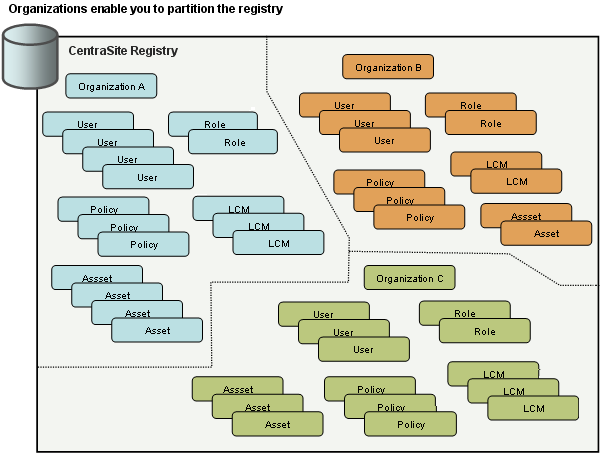Objects in the Information Model
In general, CentraSite's information model consists of system-related objects, which support the administration and management of the registry and assets, which represent the artifacts in your SOA.

System-related objects include objects such as organizations, users, groups, roles, taxonomies, policies, and lifecycle models. These type of objects do not appear in the catalog, however, they play a key role in managing its content.
The organization object in particular plays a major role within the registry. Under the registry's information model, any object that is not an organization must be associated with an organization object.
CentraSite is installed with one predefined organization. When the administrator of this organization creates users (which are represented by user objects in the registry), CentraSite automatically associates those user objects with the administrator's organization. Similarly, when those users subsequently create objects in the registry, CentraSite associates those objects with the user's organization.
When users work withCentraSite, they see only the registry objects that belong to their organization. Because organizations restrict users to the portion of the registry that belongs to their organization, they provide a way to, in effect, partition CentraSite into multiple, logical registries.
Note: | When necessary, it is possible to share objects between organizations. Using permissions, one can give a group of users in another organization permission to access a specific data object. Additionally, there are certain types of objects (such as Policies) that can be made globally available to all organizations. In both cases, however, the organization in which the objects were originally created maintains ownership of the shared objects. |
For a complete description of each of the system-related object types in the CentraSite information model, see the CentraSite Administrator’s Guide.
 Assets
Assets refer to registry objects that represent the artifacts in your SOA. As installed, the
CentraSite registry supports a set of asset types (Services, Virtual Services, REST Services, Virtual REST Services, OData Services, Virtual OData Services, XML schemas, BPEL processes, and Application Servers). Because these asset types are based on the JAXR extensible RegistryObject, you can customize the amount and type of metadata that
CentraSite maintains for each type. You can also create additional asset types as necessary. For a complete description of the installed asset types and information about defining additional asset types, see the
CentraSite Administrator’s Guide.
